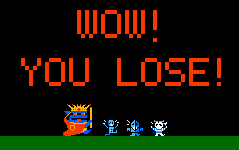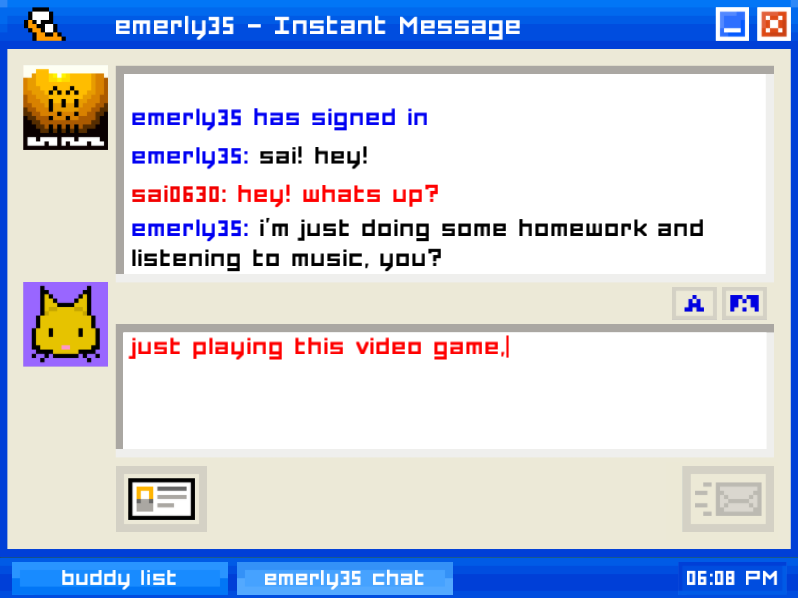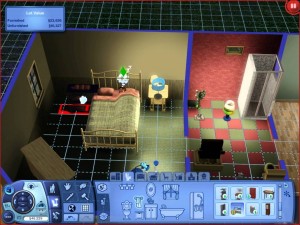The Controller is Mightier than the Pen: How Video Games Blur the Lines of Authorship
There’s an argument to be made that the video game, as a medium, is inherently post-modern. If that, as a statement, is too general or perhaps diminutive, then it’s perhaps safer to say that the medium reflects certain key characteristics of post-modernism as it appears in art: there’s a tendency towards self-reflexivity, an arguably necessary awareness of its audience, an obvious emphasis on interactivity and art that is “used”, and a blurring of boundaries between the author and the reader, or the producer and the consumer.
 In that sense, there’s almost no doubt that games are post-modern by nature: they do not exist as a passive means of entertainment, but require player interaction. Even the earliest of games had the “post-modern” tendency of, as it’s colloquially known, breaking the fourth wall and acknowledging the audience: consider non-diegetic text appearing over the screen that informs the player, ‘You lose!’, or a game over screen that asks, ‘Try again?’ – the audience is being directly addressed in these instances but rarely as a stylistic choice, simply because it’s the most efficient way of instructing the audience on what’s to come next. Games are “usable art” in the sense that the literature of a game – its stories, both embedded and emergent – cease to exist until someone interacts with the dormant coding and mechanics of the game. In his book “Postproduction: Culture as Screenplay: How Art Reprograms the World”, Nicolas Bourriaud points to “an emerging culture of use, in which meaning is born of collaboration and negotiation between the artist and the one who comes to view the work.” (Bourriaud)
In that sense, there’s almost no doubt that games are post-modern by nature: they do not exist as a passive means of entertainment, but require player interaction. Even the earliest of games had the “post-modern” tendency of, as it’s colloquially known, breaking the fourth wall and acknowledging the audience: consider non-diegetic text appearing over the screen that informs the player, ‘You lose!’, or a game over screen that asks, ‘Try again?’ – the audience is being directly addressed in these instances but rarely as a stylistic choice, simply because it’s the most efficient way of instructing the audience on what’s to come next. Games are “usable art” in the sense that the literature of a game – its stories, both embedded and emergent – cease to exist until someone interacts with the dormant coding and mechanics of the game. In his book “Postproduction: Culture as Screenplay: How Art Reprograms the World”, Nicolas Bourriaud points to “an emerging culture of use, in which meaning is born of collaboration and negotiation between the artist and the one who comes to view the work.” (Bourriaud)
On that note, games afford audiences a certain authorship in the form of emergent narratives – narratives that come from gameplay choices and player action, as opposed to the embedded plot that might supply the game’s premise. This variability in narrative form is called out by Dr. Alistair Brown in his essay “Are Video Game Narratives Postmodern?”:
“A game like Mass Effect, with 250,000 words of dialogue, might well be studied narratologically, but if so it offers a very different type of “narrative” to that of Minecraft in which the only story is that which the player writes for themselves through their own methods of creation.” (Brown)
Brown speaks to the allegedly post-modern nature of games by asserting that “As long as it [is] talked in Barthesian terms about the death of the author and licensed the reader to act as co-producer of the text, literary theory could situate games within a model that stressed narrative variability”, but goes on to argue that to simply graft the literary characteristics of post-modernism onto games is ultimately unhelpful, as games operate differently from the way the novel, the film, or the poem operates. If all games are post-modern, then are any games really post-modern? What would a post-modern game be?
Brown quotes philosopher Alan Kirby who coins the term ‘pseudo-modernism’, which does in fact take into account the computer game. Kirby says:
“Pseudo-modernism also includes computer games, which similarly place the individual in a context where they invent the cultural content, within pre-delineated limits. The content of each individual act of playing the game varies according to the particular player.” (Kirby, emphasis mine)
To effectively illustrate post- or pseudo-modernism in games, I look to a popular example: The Sims (Maxis Entertainment, Series, 2000-2016).
The Sims, as its catchy name would imply, is a game series built around the idea of simulation. The player is given an unparalleled amount of control over and asked to, essentially, create and maintain the lives of individual characters known as ‘sims’. This includes, but is certainly not limited to, designing the Sims’ physical appearances, crafting their personalities, aspirations, and character traits, building their homes, creating or managing their family and other inter-personal relations, climbing a career ladder, and more. To ask what is the exact goal or objective of The Sims is a foolhardy task, as the game is infinitely flexible to the playstyles of different players. Fulfilling a Sim’s ambitions and achieving monetary wealth and professional success is just as ‘valid’ a way to play as creating sims simply to drown them in a pool, or to not create sims at all and use the game simply as an interior decorating simulator. None of these playstyles result in a screen proclaiming that you have ‘won’ or ‘lost’, nor is there any ending set in stone within the game’s data. As such, The Sims finds its roots not in objective-based or competition-based games, but in toys like the dollhouse, that provide the player with a basic framework but invite them, ultimately, to create the cultural content of the ‘game’.
I choose to focus on a game that is so endlessly malleable because it exemplifies better than most Bourriaud’s concept of usable art. It would be much harder to map the narrative of The Sims onto another medium – for example, a film adaptation – as it would be for a more traditionally literary game like the Final Fantasy or Mass Effect series, both of which make use of far more traditional narrative devices. The Sims relies almost entirely on the player for any kind of story to emerge, and it’s this extreme level of authorship that speaks loudest to the post-modern notion of collaborative storytelling.
Bourriaud’s concept of postproduction is coded into the very way in which The Sims is played. As he claims, “The artistic question is no longer: “what can we make that is new?” but “how can we make do with what we have?” In other words, how can we produce singularity and meaning from this chaotic mass of objects, names, and references that constitutes our daily life?” (Bourriaud). In The Sims, traditional gameplay occurs in two different ‘modes’ – ‘Live Mode’, in which Sims are controllable and go about their daily lives, ‘Buy/Build Mode’, in which the Sims are frozen in place and the player is free to manipulate the world around them, usually by buying and placing furniture, constructing walls and floors, and further customizing their homes. Players select ready-made objects, wallpapers, floor designs, and more from in-game catalogs and are then free to place them however they like. Aside from pre-made houses, the game offers no guidance on where to place furniture, leaving it up to the player and their assumed ability to recognize a 3D model of a toilet as a signifier for a real toilet and its functions, and thus choose to place it in the appropriate room of a home. As such, there’s nothing stopping a player from creating a room in which there is a toilet, a pool table, and a barbecue all together (The Sims’ allowance for absurdity is, of course, also recognizably post-modern). This is all to say that, while The Sims offers a staggering amount of creativity in its gameplay, the player is rarely creating raw material, but rather recontextualizing ready-made objects and symbols in order to create further meaning: there is nothing to distinguish a bathroom from a bedroom aside from the ways in which the player chooses to design them, often drawing on their familiarity with their real-life counterparts to create combinations of objects, wallpapers, floors, etc. to create spaces that are meaningful to the player (that is to say, legible as familiar to their real-life counterparts) as well as digitally meaningful to their Sims’ coding (for example, not creating a room in which sims play pool and use the toilet at the same time, as this would simply create friction that would cause the sims to act inefficiently). As Bourriaud puts it, unintentionally summarizing the gameplay ethos of The Sims: “It is no longer a matter of elaborating a form on the basis of a raw material but working with objects that are already in circulation on the cultural market, which is to say, objects already informed by other objects.” (Bourriaud)
Bourriaud says, “To learn how to use forms … is above all to know how to make them one’s own, to inhabit them” (Bourriaud). As I’ve illustrated, the way The Sims is played is entirely about making it one’s own and tailoring gameplay to suit the individual player, but the way The Sims is used extends beyond its use as a game. The Sims can be used as, itself, a tool with which to create more art: there’s the obvious example of the game being used as a tool to create architectural art, interior designs, or character designs. Beyond even that, however, The Sims has been used to create comics, web series, music videos and other narrative forms.

NCI Comic Shorts – The Adventures of Superman (Sims 2 Edition), by ModTheSims user d_dgjdhh
These artists use the game’s assets and mechanics, in conjunction with photo or video editing software to generate more art. With the game’s ability to create unique-looking characters, the ease with which it allows the building of locations and backdrops, and its in-game camera feature capable of taking both still images and recording videos, there is no doubting the creative potential of The Sims as a generative tool. A game about recontextualizing symbolic objects to create meaningful spaces simultaneously offers symbols and materials ripe for the picking in order to create further meaningful art, a concept that strikes this academic as remarkably post-/pseudo-modern.



